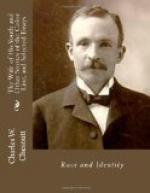In spite of the virulence and universality of race prejudice in the United States, the human intellect long ago revolted at the manifest absurdity of classifying men fifteen-sixteenths white as black men; and hence there grew up a number of laws in different states of the Union defining the limit which separated the white and colored races, which was, when these laws took their rise and is now to a large extent, the line which separated freedom and opportunity from slavery or hopeless degradation. Some of these laws are of legislative origin; others are judge-made laws, brought out by the exigencies of special cases which came before the courts for determination. Some day they will, perhaps, become mere curiosities of jurisprudence; the “black laws” will be bracketed with the “blue laws,” and will be at best but landmarks by which to measure the progress of the nation. But to-day these laws are in active operation, and they are, therefore, worthy of attention; for every good citizen ought to know the law, and, if possible, to respect it; and if not worthy of respect, it should be changed by the authority which enacted it. Whether any of the laws referred to here have been in any manner changed by very recent legislation the writer cannot say, but they are certainly embodied in the latest editions of the revised statutes of the states referred to.
The colored people were divided, in most of the Southern States, into two classes, designated by law as Negroes and mulattoes respectively. The term Negro was used in its ethnological sense, and needed no definition; but the term “mulatto” was held by legislative enactment to embrace all persons of color not Negroes. The words “quadroon” and “mestizo” are employed in some of the law books, tho not defined; but the term “octoroon,” as indicating a person having one-eighth of Negro blood, is not used at all, so far as the writer has been able to observe.
The states vary slightly in regard to what constitutes a mulatto or person of color, and as to what proportion of white blood should be sufficient to remove the disability of color. As a general rule, less than one-fourth of Negro blood left the individual white—in theory; race questions being, however, regulated very differently in practice. In Missouri, by the code of 1855, still in operation, so far as not inconsistent with the Federal Constitution and laws, “any person other than a Negro, any one of whose grandmothers or grandfathers is or shall have been a Negro, tho all of his or her progenitors except those descended from the Negro may have been white persons, shall be deemed a mulatto.” Thus the color-line is drawn at one-fourth of Negro blood, and persons with only one-eighth are white.




